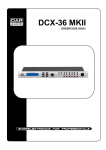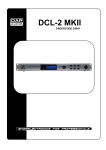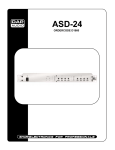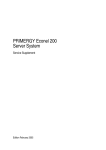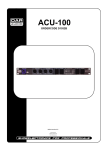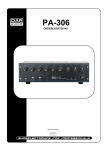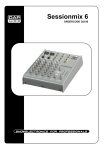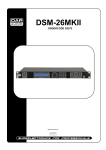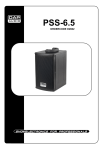Download DCX-24
Transcript
DCX-24 ORDERCODE D2020 Congratulations! You have bought a great, innovative product from DAP Audio. The DAP Audio DCX-24 brings excitement to any venue. Whether you want simple plug-&-play action or a sophisticated show, this product provides the effect you need. You can rely on DAP Audio, for more excellent audio products. We design and manufacture professional audio equipment for the entertainment industry. New products are being launched regularly. We work hard to keep you, our customer, satisfied. For more information: [email protected] You can get some of the best quality, best priced products on the market from DAP Audio. So next time, turn to DAP Audio for more great audio equipment. Always get the best -- with DAP Audio ! Thank you! DAP Audio DAP Audio DCX-24 Product Guide Warning..…...................................................................................………………………………………….. Safety-instructions………………………………………………………………………………………….…. Operating Determinations……………………………………………………………………………………. 2 2 3 Description..…..............................................................................……….………………………………… Features………………………………………………………………………………….………………….…. Overview Front side..…………………………………………………………………………………....……. Overview Back side..…………………………………………………………………………………….……. 4 4 4 5 Installation..................................................................……………………………..………………………… 5 Set Up and Operation.....................................................................……..…………………………….…… Xover submenu………………………………….……...………………………………….……...………….. Safety Options……………………………….……...………………………………….……...……………… System Menu……………………………….……...………………………………….……...……………….. Interface Menu……………………………….……...………………………………….……...……………… Parameter Menu……………………………….……...………………………………….……...…………… 5 5 6 6 6 7 Software DCX-24………………………..….…………………………..….…………………………..……..…. Main Menu.……………................................………….........................……………………..…………… Gain Settings..……………................................................….....………….........………………………... Delay Settings.………………….............…......………….........................……………………...………… Limiter Settings.............................................................................….....……………………….………... Out 1 Scene.............................................………….........................……………………....…..………… Filter Settings.......….............................................................….....…………...........………….………… Out 2 Settings……................................................................….....…………...........………………….... Out 3 Settings……................................................................….....…………...........………………….... Out 4 Settings……................................................................….....…………...........………….………… 9 9 10 10 11 11 12 12 13 13 Operation…………….……..………………………………………………………………………..….…..…… 14 Connection Cables………..………………………………………………………………………..….…..…… 15 Maintenance………..............................….......................................………..………….…….………….….. 16 Troubleshooting………..............................…................................………..………….…….………….….. 16 Product Specifications.................................................................……………….…….…………………. 17 1 WARNING CAUTION! Keep this system away from rain and moisture! FOR YOUR OWN SAFETY, PLEASE READ THIS USER MANUAL CAREFULLY BEFORE YOUR INITIAL START-UP! SAFETY INSTRUCTIONS Every person involved with the installation, operation and maintenance of this system has to: be qualified follow the instructions of this manual CAUTION! Be careful with your operations. With a dangerous voltage you can suffer a dangerous electric shock when touching the wires! Before you initial start-up, please make sure that there is no damage caused by transportation. Should there be any, consult your dealer and do not use the system. To maintain perfect condition and to ensure a safe operation, it is absolutely necessary for the user to follow the safety instructions and warning notes written in this manual. Please consider that damages caused by manual modifications to the system are not subject to warranty. This system contains no user-serviceable parts. Refer servicing to qualified technicians only. IMPORTANT: The manufacturer will not accept liability for any resulting damages caused by the non-observance of this manual or any unauthorized modification to the system. • • • • • • • • • • • • • • • • • • Never let the power-cord come into contact with other cables! Handle the power-cord and all connections with the mains with particular caution! Never remove warning or informative labels from the unit. Never use anything to cover the ground contact. Do not insert objects into air vents. Do not connect this system to a dimmerpack. Do not switch the system on and off in short intervals, as this would reduce the system’s life. Do not open this device. Risk: hazardous radiation exposure. Do not run the output of any amplifier channel, back into another channel’s input. Do not connect (parallel or series) an amplifier output with any other amplifier output. Only use system indoor, avoid contact with water or other liquids. Avoid flames and do not put close to flammable liquids or gases. Always disconnect power from the mains, when system is not used. Only handle the power-cord by the plug. Never pull out the plug by tugging the power-cord. Make sure you don’t use the wrong kind of cables or defective cables. Make sure that the signals into the mixer are balanced, otherwise hum could be created. Make sure you use DI boxes to balance unbalanced signals; All incoming signals should be clear. Make sure that the available voltage is not higher than stated on the rear panel. Make sure that the power-cord is never crimped or damaged. Check the system and the power-cord from time to time. Avoid flames and do not put close to flammable liquids or gases. 2 • • • • • • • • • • • • • • • • • • • • • • Before connecting or disconnecting the power cord, make certain the ON / OFF switch is in the OFF position. Before switching on or off make certain the sound system’s amplifiers are off or turned down: this will avoid signal peaks, which are annoying and sometimes dangerous (particularly for speaker enclosures). Avoid installing your equipment very near radio or TV sets, mobile phones, etc., as these can cause RF (radio frequency) interference. When connecting the other parts of your sound system, watch out for the so-called “ground loops”. The best way (even if not always feasible) to avoid ground loops is to connect the electric ground of all the equipment to a single central point (“star” system). In this case, the central point can be the mixer. To avoid or solve hum and buzzing troubles, try different combinations of lifting grounds on units that are supplied with ground lift switches or make sure all chassis are connected to earth ground, either through the A.C. power cord ground or by the front panel rack mount screws. Before changing your grounds around, always turn your amplifiers down. Keep this user’s manual for future consultation. Also remember that the crossover will get a better price on the secondhand market if (as well as being in good condition) it has its original documentation and packaging. Always operate the unit with the AC ground wire connected to the electrical system ground. Do not drive the inputs with a signal level bigger, than required to drive the equipment to full output. In system setup, the amplifier's output power must be 50%-100% more than the loaded loudspeakers rated power. Please turn off the power switch, when changing the power cord or signal cable, or select the input mode switch. Sometimes, when you want to send one signal to more than one amplifier, you should use a signal distributor. Extreme frequency boosts in connection with a high input signal level may lead to overdriving your equipment. Should this occur, it is necessary to reduce the input signal level by using the INPUT control. To emphasize a frequency range, you don’t necessarily have to move its respective sliding control upward; try lowering surrounding frequency ranges instead. This way, you avoid causing the next piece of equipment in your sound path to overdrive. You also preserve valuable dynamic reserve (“headroom”) For replacement use fuses of same type and rating only. Prevent distortion! Make sure that all components connected to the DCX-24 have sufficient power ratings. Otherwise distortion will be generated because the components are operated at their limits. Avoid ground loops! Always be sure to connect the power amps and the mixing console to the same electrical circuit to ensure the same phase! If system is dropped or struck, disconnect mains power supply immediately. Have a qualified engineer inspect for safety before operating. If the system has been exposed to drastic temperature fluctuation (e.g. after transportation), do not switch it on immediately. The arising condensation water might damage your system. Leave the system switched off until it has reached room temperature. Repairs, servicing and electric connection must be carried out by a qualified technician. WARRANTY: Till one year after date of purchase. OPERATING DETERMINATIONS If this system is operated in any other way, than the one described in this manual, the product may suffer damages and the warranty becomes void. Any other operation may lead to dangers like short-circuit, burns, electric shock, etc. You endanger your own safety and the safety of others! Improper installation can cause serious damage to people and property ! 3 Description of the device Features The DCX-24 is a professional crossover: • Active frequency filter with slopes up to 48 dB/octave split up the audio-signal into different frequency bands • 5 basic configurations • 5-band parametric EQ per output • Up to 7 ms signal delay for the inputs and outputs adjustable • Delay displayed in milliseconds, meters, feet and frame/second • Output limiter with adjustable limits and automatic attack and release settings as overload protection for your amplifying system • Lock-function for protecting the program settings • Phase Invert switch per output • Rs232 interface for remote control including PC software • 2x XLR Input and 4x XLR Output • Clip LED • Software included for easy set-up with DCX-24 Overview Fig. 1 1) LCD-Display: To display functions and operating status. 2) BACK-Button 3) MENU-Button 4) GAIN-Button 5) NEXT-Button 6) ENTER-Button 7) QUIT-Button 8) Parameter Knob: For adjusting the parameters. Turning the Parameter knob to the right increases the parameter value, turning to the left decreases the value. 9) Input LEDs 10) Output LEDs with MUTE-button 11) Power ON/OFF 4 Backside Fig. 2 12) IEC Connector + Fuse 13) RS232-SOCKET 14) 4x XLR Output Socket 15) 2x XLR Input Socket Installation Remove all packing materials from the DCX-24. Check that all foam and plastic padding is removed. Screw the equipment into a 19" rack. Connect all cables. Always disconnect from electric mains power supply before cleaning or servicing. Damages caused by non-observance are not subject to warranty. Set Up and Operation Before plugging the unit in, always make sure that the power supply matches the product specification voltage. Do not attempt to operate a 120V specification product on 240V power, or vice versa. Install this device on a flat surface, not bending or curved. Do not supply power before all components of the system are set up and connected properly. Main Menu Press the MENU-button (3), to enter the main menu. Select the desired submenu by pressing the BACK (2) or NEXT buttons (5) and confirm your setting with the ENTER-button (6). Xover submenu 1. Load a crossover Select the desired program via the Parameter knob (8) and confirm with the ENTER-button (6). You can only choose from already stored programs. 2. Design a crossover Select the desired setting via the Parameter knob (8) and confirm with the ENTER-button (6). DCX-24: Stereo 2-way, mono 3-way, mono 4-way Stereo-Link Only for stereo programs. The stereo link links two outputs depending on the crossover type. 3. Store a crossover You can save up to 10 programs. Press the ENTER-button (6) for saving. Select the desired program number via the Parameter knob (8). In order to move the cursor (e.g. for entering the next letter or correcting the last letter), press the BACK (2) or NEXT buttons (5). Confirm your entry by pressing the ENTER-button (6). 4. Erase a crossover Select the desired program via the Parameter knob (8) and confirm with the ENTER-button (6). 5 Safety options The DCX-24 offers you the possibility to protect your settings from any unauthorized access. 1. Change only: The parameters can be viewed but not be changed. Mute is possible. 2. Changes + View: The parameters cannot be viewed and not be changed. Mute is possible. 3. Changes + Mute: The parameters can be viewed. Changes and mute are not possible. 4. Everything: Everything is locked, nothing can be viewed and mute is not possible. In order to unlock: A) Push the BACK (2) or NEXT buttons (5), shift the cursor, turn round the PARAM to change the character. B) Push the ENTER-button (6), confirm your password and the display shows. Enter Security Code [1 2 3 4] C) Repeat step A and push the ENTER-button (6). D) System is locked when the password is the same, or the locking operation is invalid. System menu 1. Input option Switch the stereo link between channels A and B, ON or OFF. 2. Wake-up Time With this menu, you can adjust the way the DCX-24 reacts after turning on. 3. Fade-in When turning on, the outputs slowly increase to the preset output volume. Mute Hold: all output remains muted. 4. Delay Time / Distance You can adjust the delay in: milli seconds (ms) meters (m) feet (ft) Interface menu Interface-Setup Baud-Rate: Here, you can adjust the transmission speed of the RS-232 port. Press the ENTER-button (6). You can select 2400, 4800, 9600, 19200, 38400. Remote ID: you can only enter this menu after having confirmed the baud-rate with the ENTER-button (6). Here, you can adjust the device’s ID between 1 and 32. 6 PARAMETER MENU Press the GAIN-button (4) in order to enter the Parameter menu. 1. Input Gain Via the Parameter knob (8), you can adjust the input sensitivity between -40 dB and + 6 dB in 0.5 dB steps. The display shows if the inputs are linked with each other (e.g. Input A&B). For linked inputs, the gain is adjusted for both inputs. Press the NEXT-button (5) in order to jump to the next parameter. 2. Output Gain Via the Parameter knob (8), you can adjust the output volume between -40 dB and + 6 dB in 0.5 dB steps. By pressing the GAIN-button (4), you can change to Output 2 etc. The display shows if the inputs are linked with each other (e.g. OP 1&4). For linked inputs, the parameters are adjusted for both inputs. 3. Polarity-function The polarity of every output can be inverted. If the polarity of a linked output will be inverted, the polarity of the other channel will also be inverted. 4. Delay With the delay, it is possible to compensate differences in the running distances between different speaker-systems or speaker-systems at different installation spots. The delay can be adjusted for both inputs and all outputs between 0 and 7 ms in 0.5 ms steps. How to calculate the delay-time: The delay-time T equals the distance in meters (D) divided by the speed of sound (C). T=D/C How to calculate the speed of sound: C=20.6 * (273 + °C) in meter per second. 5. Hi-pass/Lo-pass Hi-pass filter for passing higher frequencies. Lo-pass filter for passing lower frequencies. If several parameters are displayed, you can switch from parameter to parameter by pressing the Parameter knob (8). The active parameter is marked with a hook. Adjust the crossover frequency and the filter type via the Parameter knob. 6. Equalizer There are five parametric equalizers per output. The individual equalizer band can be deactivated by pressing the ENTER-button (6) (Bypass). The symbol in the upper right corner of the display changes to =. If the equalizer is activated, you can adjust the frequency (20 Hz to 20 kHz), the Q-factor (0.5 to 10) and the gain (± 12 dB, ± 1 dB). By pressing the Parameter knob (8), you can jump to the next parameter. Additionally, you can switch the equalizers to shelving characteristic. Set the gain to 0 dB. If you select a Q-factor below 0, you can choose between Hi-shelf and Lo-shelf. 7 7. Limiter The DCX-24 features a limiter-function with independent limiters (one per output). The limiter serves as an additional clipping protection to avoid speaker damage. The signal level is always limited to the adjusted threshold-level. In most cases, it is sufficient to adjust the threshold-value to the clipping level of the connected amplifier. Nevertheless make sure that the amplifier does not distort. Via the Parameter knob (8), you can adjust the limiter between -20 and + 15 dB. If the limiter will be adjusted to e.g. +2,0 dB the output signal level Limit corresponds to +2 dB and the levels -2, -6, -12 and -20 dB correspond -1, -4, -8 and -12 dB. Attack You can adjust the Attack-time between 1 and 100 ms. Hold You can adjust the Hold-time between 0 and 100 ms. Decay You can adjust the Decay-time between 10 and 1000 ms. 8. Name Via the Parameter knob (8), you can select the best suitable name from a preset name list. 9. Source Via the Parameter knob (8), you can check the input sources Input A, Input B or Input A+B but not change it. 8 Software DCX-24 Insert the CD in your computer and install the CD by clicking on the DCXSetup V13-icon. Within 5 seconds this handy piece of software is installed. Be sure to connect the DCX-24 via a RS232-cable to your computer. You can already make a few different choices in the Start-up screen. Main Menu 9 Gain settings Delay Settings 10 Limiter Settings Out 1 Settings 11 Filter Settings Out 2 Settings 12 Out 3 Settings Out 4 Settings 13 14 Connection Cables In this chapter you’ll find the wiring diagrams for the connectors to be used with your crossover. Take care of the connector cables, always holding them by the connectors and avoiding knots and twists when coiling them: This gives the advantage of increasing their life and reliability, which is always to your advantage. Periodically check that your cables are in good condition, that they are correctly wired and that all their contacts are perfectly efficient: a great number of problems (faulty contacts, ground hum, discharges, etc.) are caused entirely by using unsuitable or faulty cables. 15 16 Maintenance The DCX-24 crossover requires almost no maintenance. However, you should keep the unit clean. Disconnect the mains power supply, and then wipe the cover with a damp cloth. Do not immerse in liquid. Keep connections clean. Disconnect electric power, and then wipe the audio connections with a damp cloth. Make sure connections are thoroughly dry before linking equipment or supplying electric power. Troubleshooting Dap Audio DCX-24 This troubleshooting guide is meant to help solve simple problems. If a problem occurs, carry out the steps below in sequence until a solution is found. Once the unit operates properly, do not carry out following steps. 1. If the device does not operate properly, unplug the device. 2. Check the power from the wall, all cables etc. 3. If all of the above appears to be O.K., plug the unit in again. 4. If you are unable to determine the cause of the problem, do not open the crossover, as this may damage the unit and the warranty will become void. 5. Return the crossover to your Dap Audio dealer. 17 Product Specifications Model: DAP Audio DCX-24 Power consumption: 30W Dimensions : 483 x 223 x 44.5 mm (LxWxH) Weight : 3.6 kg Inputs Inputs: 2 active, balanced Input Impedance: 10 KOhm CMRR: > 50 dB (30 Hz – 20 KHz) Frequency response: 15Hz – 20KHz (+/- 0.25dB) 15Hz – 40KHz (+/- 3dB) Input Gain Range: -40 dB – +6 dB ±0,5 dB Outputs Outputs: 4 active, balanced with automatic correction for unbalanced loading Output Impedance: <50 Ohm (electronically balanced) Output Gain Range: -40 dB – +6 dB ±0,5 dB Maximum output level: +20dBu Distortion: 0,005%, 20Hz – 20Khz S / N Ratio: > 112dB (22 Hz – 22 KHz) Channel separation: 80 dB (30 Hz – 20 KHz) Crossover frequency: 15 Hz - 20 kHz Maximum output electrical level: Vpp = 7,6V Dynamic Range Distortion THD %: <0.005% Delay: 7 ms Parametric Equalizer Filter Gain: ±12 dB in 1 dB steps Central Frequency: 20 Hz – 20 KHz 31 ISO Bands Q Value: 0,5 – 10 Shelving Equalizing Lo-shelf: 20 Hz – 1 KHz Hi-shelf: 1 KHz – 20 KHz Shelf Gain: ±12 dB in 1 dB steps Hi-Pass Filter/ Lo-Pass Filter HPF & LPF Frequency (Hi-Pass): < 10 Hz – 16 KHz Frequency (Lo-Pass): < 35 Hz – 22 KHz Response Curve: Butterworth 6 dB, 12 dB, 18 dB, 24 dB, 48 dB Bessel 12 dB, 18 dB, 24 dB, 48 dB Linkwitz-Riley 24 dB, 48 dB Limiter Level Attach Time: 1 – 100 ms Holding Time: 0 – 100 ms Decay Time: 10 – 1000 ms Input LED: -30 dB, -24 dB, -12 dB, -6 dB, -3 dB, Limit, Clip Output LED: -30 dB, -24 dB, -12 dB, -6 dB, -3 dB, Limit, Clip Design and product specifications are subject to change without prior notice. 18 2005 Dap Audio.





















